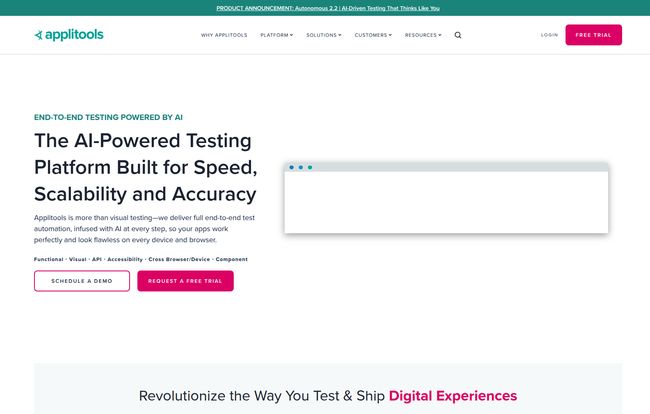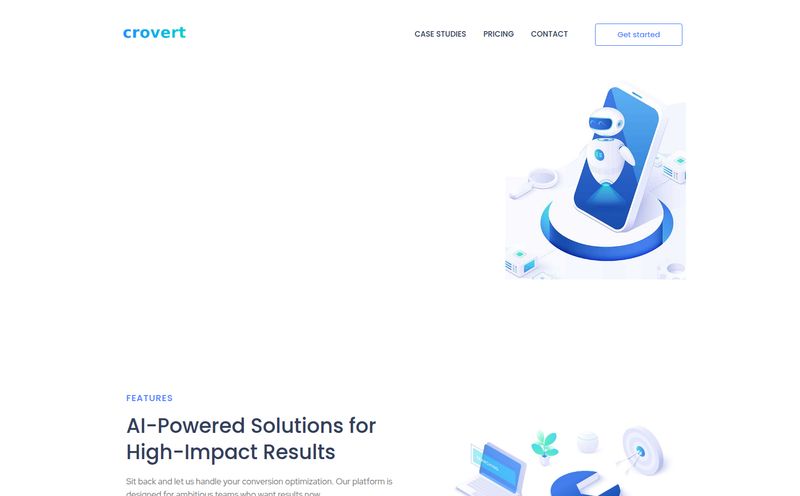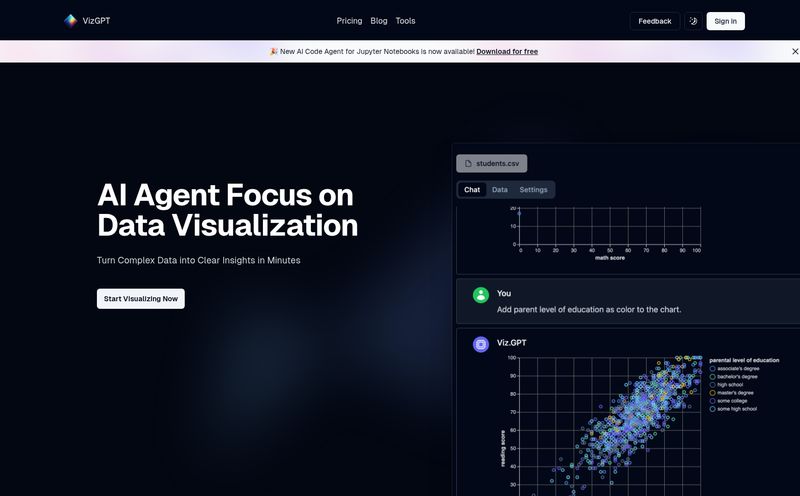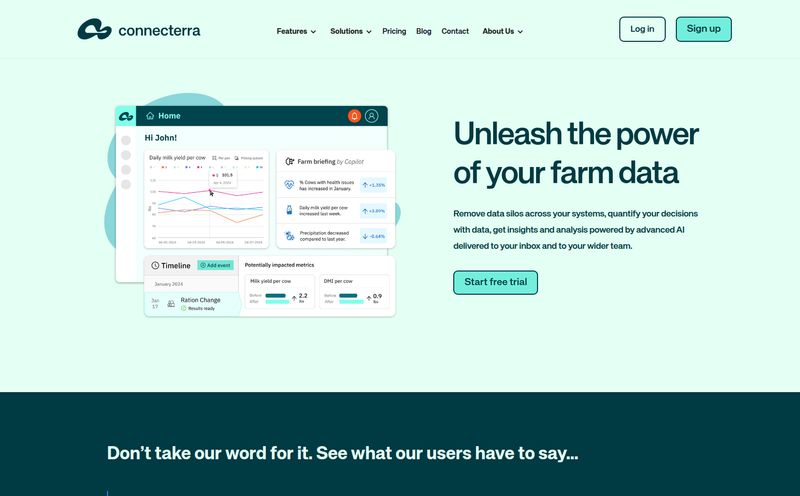We've all been there. It's the night before a big release. You think you've squashed all the bugs. The functional tests are green. You push to staging and... the hero banner is misaligned, the checkout button has vanished on Safari, and the logo looks like a pixelated mess on a high-res screen. Sigh. The dreaded visual bug.
For years, automated testing has been fantastic for checking if a function works, but it's been pretty terrible at telling you if it looks right. Traditional pixel-by-pixel comparisons are notoriously flaky, throwing false positives every time a browser renders an anti-aliased font slightly differently. It’s a maintenance nightmare that has made many teams, including some I've worked with, just give up on automated visual testing altogether.
But the landscape is shifting. AI is no longer just a buzzword to slap on a landing page. It's starting to solve real, gritty engineering problems. And that brings me to Applitools. I've been watching this platform for a while, and the claims they make are bold: 9x faster releases, 100% test coverage, and hundreds of hours saved. So, I decided to do a deep dive, cut through the marketing, and figure out if this is the real deal. Is Applitools the future of software quality, or just more hype?
What Exactly is Applitools Anyway?
At its core, Applitools is an intelligent, AI-powered platform for end-to-end testing. Think of it less like a rigid robot checking boxes and more like a junior developer with a superhuman eye for detail. It’s designed to automate the painful parts of testing—not just the functional stuff, but the visual and user experience aspects too. It combines several clever bits of tech, from what they call 'Visual AI' to Generative AI, to create, run, and even maintain your test suites.
The old way of testing was like proofreading a 500-page novel by comparing it to the manuscript one letter at a time. Tedious. Prone to error. You’d go crazy. Applitools is more like an expert editor who reads a chapter, understands the content and layout, and then flags when a paragraph has lost its meaning or a picture is in the wrong place—even if the word count is the same. It understands intent, and in the world of UI, that's everything.
The Killer Features That Actually Matter
A feature list is just a list. What matters is how those features solve the problems that give us engineers and product managers gray hair. Here's what stood out to me.
Visual AI and the Ultrafast Grid
This is the secret sauce. The heart of the platform. Instead of dumb pixel comparisons, Applitools' Visual AI analyzes an application's UI like a human would. It identifies the individual elements on the page—buttons, images, text blocks—and understands their relationship to each other. This means it won't have a meltdown if a dynamic ad changes or a browser renders a shadow a tiny bit differently. It's smart enough to ignore the noise and spot the real bugs. This dramatically reduces the false positives that plague older tools.
Coupled with their Ultrafast Grid, you can run these visual checks across countless combinations of browsers, devices, and viewports in seconds, not hours. It’s cross-browser testing without the soul-crushing infrastructure headache.
Autonomous Testing: Your New AI Intern?
This is the newer, more headline-grabbing part of the platform. Using a blend of AI and Natural Language Processing (NLP), Applitools can now create and maintain tests for you. You can literally write test steps in plain English, and it builds the test. More impressively, it can scan your application, identify user flows, and generate a baseline test suite automatically. This is a massive leg up for teams that are behind on test coverage or just don't have the resources to write thousands of lines of test code.

Visit Applitools
Self-Healing Tests and Root Cause Analysis
Here’s the thing that made me nod in appreciation. We all know how brittle UI tests can be. A developer changes a CSS selector ID, and BAM—half the test suite fails. Applitools’ AI is designed to be resilient to these kinds of changes. If a button's ID changes but it's still visually and functionally the same button in the same place, the AI often recognizes it and heals the test on its own. It adapts. This alone could save a team dozens of hours a month in test maintenance.
And when a test does fail, it doesn't just give you a red X. It provides a root cause analysis, highlighting the exact DOM and CSS changes that caused the visual difference. No more hunting around in Chrome DevTools for hours.
So, Who is This Really For?
While their website mentions being trusted by "Global 1000" brands, I don't think this is just an enterprise play. I see this being incredibly valuable for a few key groups:
- Fast-Moving Agile Teams: If you're deploying multiple times a day, you don't have time for manual regression testing. This provides the safety net to move quickly without breaking the user experience.
- Front-End Developers: Let's be real, most front-end devs I know would rather be building cool stuff than writing finicky test scripts. Applitools can take a huge testing load off their shoulders.
- QA Engineers and SDETs: This tool doesn't replace QA professionals; it empowers them. It frees them from the monotony of manual checks and flaky scripts to focus on more complex edge cases, exploratory testing, and overall quality strategy.
Let's Talk Money: The Applitools Pricing Breakdown
Okay, let's address the elephant in the room: the price. Navigating the pricing page can feel a bit like reading a phone plan contract, but I'll try to simplify it. Applitools essentially breaks its offering into a few products, mainly Autonomous (for the full end-to-end AI-driven testing) and Eyes (focused purely on the Visual AI component). Each has tiers.
Here’s a simplified look at the main plans. Keep in mind, prices are often listed as "billed annually."
| Plan Type | Cost | Best For | Key Features |
|---|---|---|---|
| Autonomous Free Trial | $0 for 14 days | Trying out the full suite | Unlimited users, 25 autonomous tests |
| Autonomous Starter | $969 / month | Small to medium teams | Unlimited users, 50 autonomous tests, 10 concurrent tests |
| Eyes Free | $0 | Individuals or very small projects | 1 user, 50 pages/month (visual checks) |
| Eyes Starter | $899 / month | Teams focused on visual testing | Unlimited users, 50 pages, 10 concurrent tests |
| Enterprise | Custom | Large organizations | More tests, more concurrency, on-prem options, dedicated support |
For the most current details, you should always check the official Applitools pricing page.
The Good, The Bad, and The AI-Powered
No tool is perfect. After my analysis, here’s my honest breakdown.
What I Genuinely Like
The reduction in flaky tests is, for me, the number one benefit. It moves visual testing from a theoretical nice-to-have to a practical reality. The time saved not just in writing tests, but in maintaining them, is a huge force multiplier. I also love the confidence it gives teams to ship faster. When you trust your safety net, you're more willing to take the leap. The sheer speed of the Ultrafast Grid is also incredibly impressive.
Things to Keep in Mind
Let's be real, the price tag isn't trivial. For small startups or indie developers, the starter plans might still be a stretch. The value proposition is all about ROI—if you're saving a senior developer 20 hours a month, it pays for itself easily. But you have to be at a scale where that math works. There's also a learning curve. It's not zero. While it’s more intuitive than many dev tools, you still need to understand how to integrate it into your CI/CD pipeline and how to manage baselines effectively. It's a powerful tool, but it wont magically solve all your problems without some initial effort. Finally, you can't blindly trust the AI. A human still needs to set the initial baseline and approve changes. The AI is an assistant, not a replacement for a good QA mindset.
Final Thoughts: Is Applitools Worth the Investment?
After digging in, I've moved from skeptical to cautiously optimistic to genuinely impressed. Applitools isn't just another testing tool. It feels like a paradigm shift in how we approach software quality. By tackling the messy, subjective, and time-consuming world of visual validation with smart AI, it solves a problem that many of us in the industry had written off as too hard to automate reliably.
Is it for everyone? Maybe not. If you're a one-person shop building a simple static site, it's overkill. But if you're part of a professional team building complex web and mobile applications, and you're constantly battling regressions, slow release cycles, and the fear of shipping visual bugs, then yes. Applitools is absolutely worth a serious look. It's an investment, for sure, but the cost of a critical bug hitting production is always higher.
Frequently Asked Questions
- How is Applitools different from something like Selenium or Cypress?
- Great question. It's not an either/or. Applitools integrates with tools like Selenium and Cypress. Those tools are fantastic for driving the browser (clicking buttons, filling forms). Applitools then adds the 'vision' on top, validating the visual and functional correctness of the UI at each step, something Selenium can't do on its own.
- Is Applitools hard to learn?
- It's easier than you might think, especially if you're already familiar with automated testing concepts. The documentation is solid, and adding the Visual AI check to an existing test script is often just a couple of lines of code. The newer autonomous features aim to make it even easier, even for non-coders.
- Can I use Applitools for mobile app testing?
- Yes, absolutely. The platform supports native mobile applications (iOS and Android) in addition to web apps, allowing you to have a consistent quality process across all your digital properties.
- Is the free 'Eyes Free' plan good enough to start with?
- The Eyes Free plan is perfect for a solo developer or for evaluating the core Visual AI on a small project. The limit of one user and 50 pages/month means a team will outgrow it quickly, but it's an excellent, no-risk way to see the magic for yourself.
- What does it mean by 'Pages' or 'Checkpoints' in the pricing?
- This is their way of measuring usage. A single 'page' in their pricing can be equivalent to thousands of individual 'checkpoints' or assertions. Basically, instead of charging you for every single little check, they bundle it into a more holistic metric based on screen captures. The free plan's 50 pages is comparable to 50,000 checkpoints, which is quite generous for a trial.
- Does the AI ever get it wrong?
- Yes, no AI is perfect. There might be instances where it flags a change you consider acceptable or misses a very subtle issue. That's why the human-in-the-loop workflow is so important. You are the ultimate authority, telling the AI what to accept as a new baseline for future tests. It learns from your feedback.
Reference and Sources
- Applitools Official Website
- Applitools Official Pricing Page
- TestGuild's Independent Review of Applitools



